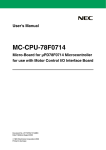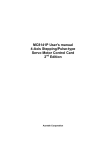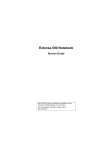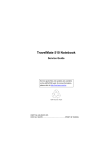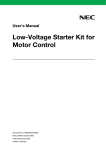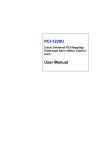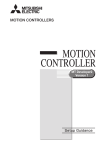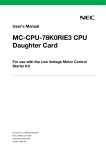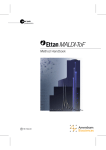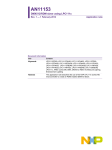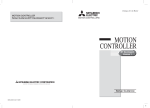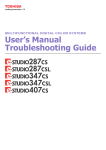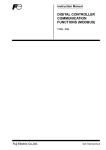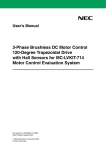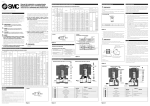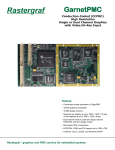Download Low-Voltage Power Module For Motor Control User`s Manual
Transcript
User’s Manual Low-Voltage Power Module For Motor Control Document No. U18052EU1V1UME0 Date Published August 2006 © NEC Electronics Corporation 2006 Printed in Germany CAUTION This is a Test- and Measurement equipment with possibility to be significantly altered by user through hardware enhancements/modifications and/or test or application software. Thus, with respect to Council Directive 89/336/EEC (Directive on compliance with the EMC protection requirements), this equipment has no autonomous function. Consequently this equipment is not marked by the CE-symbol. EEDT-ST-0005-10 Redemption of Waste Electrical and Electronic Equipment (WEEE) in accordance with legal regulations applicable in the European Union only: This equipment (including all accessories) is not intended for household use. After use the equipment cannot be disposed of as household waste. NEC Electronics (Europe) GmbH offers to take back the equipment. All you need to do is register at www.eu.necel.com/weee. All (other) product, brand, or trade names used in this pamphlet are the trademarks or registered trademarks of their respective owners. Product specifications are subject to change without notice. To ensure that you have the latest product data, please contact your local NEC Electronics sales office. 2 User’s Manual U18052EU1V1UME0 NOTES FOR CMOS DEVICES 1 VOLTAGE APPLICATION WAVEFORM AT INPUT PIN Waveform distortion due to input noise or a reflected wave may cause malfunction. If the input of the CMOS device stays in the area between VIL (MAX) and VIH (MIN) due to noise, etc., the device may malfunction. Take care to prevent chattering noise from entering the device when the input level is fixed, and also in the transition period when the input level passes through the area between VIL (MAX) and VIH (MIN). 2 HANDLING OF UNUSED INPUT PINS Unconnected CMOS device inputs can be cause of malfunction. If an input pin is unconnected, it is possible that an internal input level may be generated due to noise, etc., causing malfunction. CMOS devices behave differently than Bipolar or NMOS devices. Input levels of CMOS devices must be fixed high or low by using pull-up or pull-down circuitry. Each unused pin should be connected to VDD or GND via a resistor if there is a possibility that it will be an output pin. All handling related to unused pins must be judged separately for each device and according to related specifications governing the device. 3 PRECAUTION AGAINST ESD A strong electric field, when exposed to a MOS device, can cause destruction of the gate oxide and ultimately degrade the device operation. Steps must be taken to stop generation of static electricity as much as possible, and quickly dissipate it when it has occurred. Environmental control must be adequate. When it is dry, a humidifier should be used. It is recommended to avoid using insulators that easily build up static electricity. Semiconductor devices must be stored and transported in an anti-static container, static shielding bag or conductive material. All test and measurement tools including work benches and floors should be grounded. The operator should be grounded using a wrist strap. Semiconductor devices must not be touched with bare hands. Similar precautions need to be taken for PW boards with mounted semiconductor devices. 4 STATUS BEFORE INITIALIZATION Power-on does not necessarily define the initial status of a MOS device. Immediately after the power source is turned ON, devices with reset functions have not yet been initialized. Hence, power-on does not guarantee output pin levels, I/O settings or contents of registers. A device is not initialized until the reset signal is received. A reset operation must be executed immediately after power-on for devices with reset functions. 5 POWER ON/OFF SEQUENCE In the case of a device that uses different power supplies for the internal operation and external interface, as a rule, switch on the external power supply after switching on the internal power supply. When switching the power supply off, as a rule, switch off the external power supply and then the internal power supply. Use of the reverse power on/off sequences may result in the application of an overvoltage to the internal elements of the device, causing malfunction and degradation of internal elements due to the passage of an abnormal current. The correct power on/off sequence must be judged separately for each device and according to related specifications governing the device. 6 INPUT OF SIGNAL DURING POWER OFF STATE Do not input signals or an I/O pull-up power supply while the device is not powered. The current injection that results from input of such a signal or I/O pull-up power supply may cause malfunction and the abnormal current that passes in the device at this time may cause degradation of internal elements. Input of signals during the power off state must be judged separately for each device and according to related specifications governing the device. User’s Manual U18052EU1V1UME0 3 • The information in this document is current as of August, 2006. The information is subject to change without notice. For actual design-in, refer to the latest publications of NEC Electronics data sheets or data books, etc., for the most up-to-date specifications of NEC Electronics products. Not all products and/or types are available in every country. Please check with an NEC Electronics sales representative for availability and additional information. • No part of this document may be copied or reproduced in any form or by any means without the prior written consent of NEC Electronics. NEC Electronics assumes no responsibility for any errors that may appear in this document. • NEC Electronics does not assume any liability for infringement of patents, copyrights or other intellectual property rights of third parties by or arising from the use of NEC Electronics products listed in this document or any other liability arising from the use of such products. No license, express, implied or otherwise, is granted under any patents, copyrights or other intellectual property rights of NEC Electronics or others. • Descriptions of circuits, software and other related information in this document are provided for illustrative purposes in semiconductor product operation and application examples. The incorporation of these circuits, software and information in the design of a customer's equipment shall be done under the full responsibility of the customer. NEC Electronics assumes no responsibility for any losses incurred by customers or third parties arising from the use of these circuits, software and information. • While NEC Electronics endeavors to enhance the quality, reliability and safety of NEC Electronics products, customers agree and acknowledge that the possibility of defects thereof cannot be eliminated entirely. To minimize risks of damage to property or injury (including death) to persons arising from defects in NEC Electronics products, customers must incorporate sufficient safety measures in their design, such as redundancy, fire-containment and anti-failure features. • NEC Electronics products are classified into the following three quality grades: "Standard", "Special" and "Specific". The "Specific" quality grade applies only to NEC Electronics products developed based on a customerdesignated "quality assurance program" for a specific application. The recommended applications of an NEC Electronics product depend on its quality grade, as indicated below. Customers must check the quality grade of each NEC Electronics product before using it in a particular application. "Standard": Computers, office equipment, communications equipment, test and measurement equipment, audio and visual equipment, home electronic appliances, machine tools, personal electronic equipment and industrial robots. "Special": Transportation equipment (automobiles, trains, ships, etc.), traffic control systems, anti-disaster systems, anti-crime systems, safety equipment and medical equipment (not specifically designed for life support). "Specific": Aircraft, aerospace equipment, submersible repeaters, nuclear reactor control systems, life support systems and medical equipment for life support, etc. The quality grade of NEC Electronics products is "Standard" unless otherwise expressly specified in NEC Electronics data sheets or data books, etc. If customers wish to use NEC Electronics products in applications not intended by NEC Electronics, they must contact an NEC Electronics sales representative in advance to determine NEC Electronics' willingness to support a given application. (Note) (1) "NEC Electronics" as used in this statement means NEC Electronics Corporation and also includes its majority-owned subsidiaries. (2) "NEC Electronics products" means any product developed or manufactured by or for NEC Electronics (as defined above). M8E 02. 11-1 4 User’s Manual U18052EU1V1UME0 For further information, please contact: NEC Electronics Corporation 1753, Shimonumabe, Nakahara-ku, Kawasaki, Kanagawa 211-8668, Japan Tel: 044-435-5111 http://www.necel.com/ [America] [Europe] [Asia & Oceania] NEC Electronics America, Inc. 2880 Scott Blvd. Santa Clara, CA 95050-2554, U.S.A. Tel: 408-588-6000 800-366-9782 http://www.am.necel.com/ NEC Electronics (Europe) GmbH Arcadiastrasse 10 40472 Düsseldorf, Germany Tel: 0211-65030 http://www.eu.necel.com/ NEC Electronics (China) Co., Ltd 7th Floor, Quantum Plaza, No. 27 ZhiChunLu Haidian District, Beijing 100083, P.R.China Tel: 010-8235-1155 http://www.cn.necel.com/ Hanover Office Podbielskistrasse 166 B 30177 Hannover Tel: 0 511 33 40 2-0 Munich Office Werner-Eckert-Strasse 9 81829 München Tel: 0 89 92 10 03-0 Stuttgart Office Industriestrasse 3 70565 Stuttgart Tel: 0 711 99 01 0-0 United Kingdom Branch Cygnus House, Sunrise Parkway Linford Wood, Milton Keynes MK14 6NP, U.K. Tel: 01908-691-133 Succursale Française 9, rue Paul Dautier, B.P. 52180 78142 Velizy-Villacoublay Cédex France Tel: 01-3067-5800 Sucursal en España Juan Esplandiu, 15 28007 Madrid, Spain Tel: 091-504-2787 NEC Electronics Shanghai Ltd. Room 2509-2510, Bank of China Tower, 200 Yincheng Road Central, Pudong New Area, Shanghai P.R. China P.C:200120 Tel: 021-5888-5400 http://www.cn.necel.com/ NEC Electronics Hong Kong Ltd. 12/F., Cityplaza 4, 12 Taikoo Wan Road, Hong Kong Tel: 2886-9318 http://www.hk.necel.com/ Seoul Branch 11F., Samik Lavied’or Bldg., 720-2, Yeoksam-Dong, Kangnam-Ku, Seoul, 135-080, Korea Tel: 02-558-3737 NEC Electronics Taiwan Ltd. 7F, No. 363 Fu Shing North Road Taipei, Taiwan, R. O. C. Tel: 02-8175-9600 http://www.tw.necel.com/ NEC Electronics Singapore Pte. Ltd. 238A Thomson Road, #12-08 Novena Square, Singapore 307684 Tel: 6253-8311 http://www.sg.necel.com/ Tyskland Filial Täby Centrum Entrance S (7th floor) 18322 Täby, Sweden Tel: 08 638 72 00 Filiale Italiana Via Fabio Filzi, 25/A 20124 Milano, Italy Tel: 02-667541 Branch The Netherlands Steijgerweg 6 5616 HS Eindhoven The Netherlands Tel: 040 265 40 10 G06.8A User’s Manual U18052EU1V1UME0 5 [MEMO] 6 User’s Manual U18052EU1V1UME0 Preface Readers This manual is intented for users who want to understand the functions of the low voltage power module for motor control. Purpose This manual presents the hardware manual of the low voltage power module for motor control. Organization This system specification describes the following sections: Legend • Inverter module • IGBT module • Opto isolation • Power supplies • User connections Symbols and notation are used as follows: Weight in data notation : Left is high-order column, right is low order column Active low notation : xxx (pin or signal name is over-scored) or /xxx (slash before signal name) Memory map address: : High order at high stage and low order at low stage Note : Explanation of (Note) in the text Caution : Item deserving extra attention Remark : Supplementary explanation to the text Numeric notation : Binary... XXXX or XXXB Decimal... XXXX Hexadecimal... XXXXH or 0x XXXX Prefixes representing powers of 2 (address space, memory capacity) K (kilo): 210 = 1024 M (mega): 220 = 10242 = 1,048,576 G (giga): 230 = 10243 = 1,073,741,824 User’s Manual U18052EU1V1UME0 7 8 User’s Manual U18052EU1V1UME0 Table of Contents Preface . . . . . . . . . . . . . . . . . . . . . . . . . . . . . . . . . . . . . . . . . . . . . . . . . . . . . . . 7 Chapter 1 1.1 1.2 1.3 Chapter 2 Introduction. . . . . . . . . . . . . . . . . . . . . . . . . . . . . . . . . . . . . . . . . . . . . . . . . . . 15 Micro-Board Connection to Motor Control I/O Board . . . . . . . . . . . . . . . . . . . . . . . . 16 Low-Voltage Power Module Connection to Motor Control I/O Board . . . . . . . . . . . 17 Signal Definitions . . . . . . . . . . . . . . . . . . . . . . . . . . . . . . . . . . . . . . . . . . . . . . . . . . . . . 18 Specifications . . . . . . . . . . . . . . . . . . . . . . . . . . . . . . . . . . . . . . . . . . . . . . . . . 19 2.1 2.2 Physical Placement of Components . . . . . . . . . . . . . . . . . . . . . . . . . . . . . . . . . . . . . . 20 Operating Modes . . . . . . . . . . . . . . . . . . . . . . . . . . . . . . . . . . . . . . . . . . . . . . . . . . . . . . 20 2.2.1 Normal operation . . . . . . . . . . . . . . . . . . . . . . . . . . . . . . . . . . . . . . . . . . . . . . . . 20 2.2.2 Debugging configuration . . . . . . . . . . . . . . . . . . . . . . . . . . . . . . . . . . . . . . . . . . 20 2.3 On-Board Components . . . . . . . . . . . . . . . . . . . . . . . . . . . . . . . . . . . . . . . . . . . . . . . . 21 2.3.1 40-pin ribbon cable header . . . . . . . . . . . . . . . . . . . . . . . . . . . . . . . . . . . . . . . . 22 2.3.2 3-pin terminal block . . . . . . . . . . . . . . . . . . . . . . . . . . . . . . . . . . . . . . . . . . . . . . 23 2.3.3 Current sense output connections . . . . . . . . . . . . . . . . . . . . . . . . . . . . . . . . . . . 24 2.3.4 Phase-voltage sense . . . . . . . . . . . . . . . . . . . . . . . . . . . . . . . . . . . . . . . . . . . . . 24 Chapter 3 3.1 3.2 3.3 3.4 3.5 3.6 3.7 Chapter 4 Appendix . . . . . . . . . . . . . . . . . . . . . . . . . . . . . . . . . . . . . . . . . . . . . . . . . . . . 25 Digital-Signal Isolation . . . . . . . . . . . . . . . . . . . . . . . . . . . . . . . . . . . . . . . . . . . . . . . . . 25 Analog-Signal Isolation . . . . . . . . . . . . . . . . . . . . . . . . . . . . . . . . . . . . . . . . . . . . . . . . 26 Note on Analog Signal Isolation . . . . . . . . . . . . . . . . . . . . . . . . . . . . . . . . . . . . . . . . . . 28 Back-EMF Zero-Cross-Detection Comparator . . . . . . . . . . . . . . . . . . . . . . . . . . . . . . 29 Current Sense and MCU Interface . . . . . . . . . . . . . . . . . . . . . . . . . . . . . . . . . . . . . . . . 30 Over-Current Protection . . . . . . . . . . . . . . . . . . . . . . . . . . . . . . . . . . . . . . . . . . . . . . . . 31 Safety Shut-Down . . . . . . . . . . . . . . . . . . . . . . . . . . . . . . . . . . . . . . . . . . . . . . . . . . . . . 32 Schematics . . . . . . . . . . . . . . . . . . . . . . . . . . . . . . . . . . . . . . . . . . . . . . . . . . . 35 User’s Manual U18052EU1V1UME0 9 10 User’s Manual U18052EU1V1UME0 List of Figures Figure 1-1: Figure 1-2: Figure 1-3: Figure 2-1: Figure 2-2: Figure 2-3: Figure 3-1: Figure 3-2: Figure 3-3: Figure 3-4: Figure 3-5: Figure 3-6: Figure 3-7: Figure 3-8: Low-Voltage Motor Control Power Module................................................................. 15 Development Boards for Motor Control ....................................................................... 16 Development Board Connections................................................................................ 17 Power Module Layout.................................................................................................. 20 40-Pin Header Signals ................................................................................................ 22 3-Pin Terminal Signals ................................................................................................ 23 Digital Isolation Circuit ................................................................................................. 25 Analog Isolation Circuit................................................................................................ 26 Adjustable Analog Isolation Circuit .............................................................................. 27 Back-EMF Comparator Circuit..................................................................................... 29 Current-Sense Circuit .................................................................................................. 30 Trip Circuit for Hardware Shutdown ............................................................................ 31 Safety Shutdown Circuit .............................................................................................. 32 Safety Shutdown Selection Circuit .............................................................................. 33 User’s Manual U18052EU1V1UME0 11 12 User’s Manual U18052EU1V1UME0 List of Tables Table 1-1: Table 2-1: Table 2-2: Table 2-3: Table 2-4: Table 2-5: 40-Pin Header Signals.................................................................................................... 18 Default Jumper Settings ................................................................................................. 20 Power Inputs................................................................................................................... 21 Power Terminal Connections ......................................................................................... 21 Power Selection Jumpers............................................................................................... 21 Solder Blob Connections ................................................................................................ 23 User’s Manual U18052EU1V1UME0 13 14 User’s Manual U18052EU1V1UME0 Chapter 1 Introduction The low-voltage motor control power module from NEC Electronics is designed to drive low-voltage, three-phase, permanent-magnet asynchronous-current (PMAC) motors such as brushless DC (BLDC) and permanent-magnet sinusoidal motors (PMSM). The module contains a six-transistor power MOSFET H-bridge, driver circuits, optical isolation and feedback signal conditioning circuits. Figure 1-1: Low-Voltage Motor Control Power Module To evaluate a complete PMAC motor drive system, you need three parts that are all available from NEC Electronics: • A micro-board containing a motor-control microcontroller • A motor control I/O board (MC-I/O-GENERAL board) that interfaces between the micro-board and the power module • The low-voltage power module containing the power MOSFETs By adding a low-voltage PMAC motor and software packages that support various driving methods and control algorithms, you can quickly explore the principals of three-phase PMAC motor control as well as jump start your application development with minimum effort. User’s Manual U18052EU1V1UME0 15 Chapter 1 Introduction 1.1 Micro-Board Connection to Motor Control I/O Board The micro-board contains an NEC Electronics microcontroller that supports three-phase motor-control functions. NEC Electronics offers a series of dedicated motor control microcontrollers ranging from 8-bit CISC-type devices to high-performance 32-bit RISC products. Please contact your NEC Electronics America sales representative to obtain a list of available choices. Development Boards for Motor Control P1 = FX8C-100S-SV5 Receptacle 3.5 - Inches I/O pins I/O pins Reset, Clock and Optional connections LED2 J2 = FX8C-100P-SV4 Header 4 - Inches LED3 Motor Control Microcontrollers Flash Programming and Debugging Interface Push Buttons LED1 Operation Control LEDs and Switches Motor control I/O Board Prototype Area Terminal Block LED0 I/O pins OCD-Header Reset, Clock and Optional connections TrimPot Speed Adjust J5 Motor Unit Signals Power Jack 16-pin Header J1 = FX8C-100P-SV4 Header 40-pin Header Power-Module Signals J4 Micro-Board Optional 15 V @ 1 A Motor Control I/O Board I/O pins Figure 1-2: P2 = FX8C-100S-SV5 Receptacle Approx. 0.75 - Inch 2 - Inches The micro-board connects to the motor-control I/O board via two 100-pin connectors. All MCU signals connect to the I/O board hardware or prototype area. The I/O board interfaces between the motor-control power module and the microboard containing the microcontroller. 16 User’s Manual U18052EU1V1UME0 Chapter 1 Introduction 1.2 Low-Voltage Power Module Connection to Motor Control I/O Board Development Board Connections J1 = FX8C-100P-SV4 Header Phase Voltage Sensing Push Buttons LED0 LED1 Operation Control LEDs and Switches Terminal Block Analogue Opto-Isolators J5 Low-Side Current Sensing Power Jack TrimPot Speed Adjust 40-pin Header Ribbon Cable 40-pin Header J4 Digital Opto-Isolators MOSFET Driver Back-EMF Zero-Cross Detection Power MOSFETS Phase_W Phase_V Phase_U Power Jack Motor Control I/O Board Optional 15 V @ 1 A VIN_PWR Motor Control Low-Voltage Power Module Motor control I/O Board Prototype Area Figure 1-3: LED2 J2 = FX8C-100P-SV4 Header HALL Sensor Signals 4 - Inches LED3 Approx. 0.75 - Inch PMAC Motor The low-voltage motor control power module connects to the I/O board through a 40-pin ribbon cable. This cable carries pulse-width modulation (PWM) signals from the MCU, as well as motor-control and sensing signals to the MCU; all of these signals pass through the I/O board. When Hall sensors are used, connect their signal lines directly to the terminal block J5 on the I/O board. The low-voltage motor control power module has its own power terminals. It is best to use these terminals, although you can supply the module with up to 15V/2A power through the I/O board. Use only one of these methods of supplying power as described in sections 3.3.1 and 3.3.2 of this manual. User’s Manual U18052EU1V1UME0 17 Chapter 1 Introduction 1.3 Signal Definitions Table 1-1: Category 40-Pin Header Signals Signal Name Signal Description VCC_15V Power input to MC I//O board VCC_5V Regulated 5V power PWM signals HI_U, HI_V, HI_W: high-side FET drive LO_U, LO_V, LO_W: low-side FET drive PWM signals from CPU Back-EMF comparator CMPU, CMPV, CMPW Back-EMF comparator signals from power module connected to interrupt inputs of CPU Current sense signals ANI0_IU, ANI1_IV, ANI2_IW ISHUNT Motor phase current: low-side current detection Motor shunt current: low-side current detection Connected to A/D converter inputs of CPU PX_ITRIP Over-current detection signal from power module Connected to Port_X of CPU for further action TRIP CPU-generated signal Turn-off power for power MOSFETs Phase-voltage detection V-U, V-V, V-W Motor phase voltage-detection signal Connected to A/D converter inputs of CPU Power module temperature ANI7_TMP Power-module temperature-sense signal Connected to A/D converter input of CPU System power Safety control signals 18 User’s Manual U18052EU1V1UME0 Chapter 2 Specifications The motor-control low-voltage power module has on-board hardware for controlling and operating PMAC motors. Low-voltage power module specification: • System power - Power jack: up to 24 VDC at 4A - External power terminal: up to 24 VDC at 4A - VCC_15V from MC I/O board - ON/OFF power switch - 4A fast-acting fuse - Power-select jumper • 40-pin ribbon cable that carries signals to/from motor control I/O board • 3-pin terminal block: Phase_U, Phase_V and Phase_W signal connections to PMAC motor terminals • Opto-coupler isolation that physically separates high- and low-voltage plane - Digital opto-isolators that isolate and couple digital signals - Analog opto-isolators signals isolate and couple analog signals - Ground-shorting jumpers: high- and low-voltage GND-plane shorting jumpers - Connect two power planes when motor power is supplied from the MC-I/O board VCC_15V - Remove GND-shorting jumpers when motor power is supplied from either the external power jack or the external power terminal • Board size of 3.5 × 5.5 inches (W × L) User’s Manual U18052EU1V1UME0 19 Chapter 2 Specifications 2.1 Physical Placement of Components 40-Pin Header – Connection to MC-I/O-Board Power Module Layout Power Select Jumper Power Jack Power Switch 4A Fast Acting Fuse 3-Pin Terminal Block Figure 2-1: Motor Drive Power MOSFETs with Heat Sink Table 2-1: Jumper JP1 Jumper Setting 2–4 Functions Default Jumper Settings Descriptions Selects 15 volts Selects power module VCC_15PW from I/O module VCC_15V JP2–JP11 Short GND-shorting jumpers Connects high-voltage GND plane to low-voltage GND plane JP12 Selects 5 volts Select power module VCC_5PW from I/O module VCC_5V 2–4 2.2 Operating Modes 2.2.1 Normal operation The low-voltage power module operates as part of a BLDC or PMAC motor control system when connected to a motor-control I/O board that has a micro-board attached. 2.2.2 Debugging configuration The methods used to debug the motor controller depend on the micro-board you use. Consult your micro-board user’s manual for details. 20 User’s Manual U18052EU1V1UME0 Chapter 2 Specifications Table 2-2: Power Inputs 2.3 On-Board Components Power Terminal J4 Function Description Main power jack J1RED/J1Black External power input 24 VDC at 4A from user-supplied wall-mount power supplies User-supplied power-input terminal; two single-jacks (red and black) Table 2-3: Power Terminal J2 Function Power Terminal Connections Connections Power source select Description 1–2 and 3–4 Power from user-supplied external power J1RED/ J1BLK 5–6 and 7–8 VCC_15V coming from I/O board 9–10 and 11–12 Power from main power jack J4 When selecting power from the motor control I/O board, you must set JP1 and JP12 as shown in the table. Table 2-4: Jumper JP1 JP12 Function Power Selection Jumpers Jumper Setting 15VDC power source select 5VDC power source select Description 1–2 From power module to VCC_15V MC-I/O board 3–4 From power module to VCC_15PW for power module 2–4 From MC-I/O board to power module 1–2 From power module to VCC_5V MC-I/O board 3–4 From power module to VCC_5PW for power module 2–4 From MC-I/O board to power module User’s Manual U18052EU1V1UME0 21 Chapter 2 Specifications 2.3.1 40-pin ribbon cable header The 40-pin ribbon cable connects motor-control and motor feedback signals between the power module and the I/O board. The signals on the cable header connect to the MCU after passing through isolation and signal conditioning circuits. Figure 2-2: 22 40-Pin Header Signals User’s Manual U18052EU1V1UME0 Chapter 2 Specifications 2.3.2 3-pin terminal block A 3-pin terminal block connects Phase_U, Phase_V and Phase_W signals to the PMAC motor. However, other signals from the motor such as those from the Hall sensor or shaft encoder can be connected directly to the MC-I/O board (J5) and from there to the CPU. Figure 2-3: Table 2-5: Solder Blob Function 3-Pin Terminal Signals Solder Blob Connections SB Connection Description IU_PW to ANI0_IU SB16 and SB18 (current sense at Phase_U) Connect SB16 Use optional analog opto-isolator to connect IU_PW to ANI0_IU Connect SB18 IU_PW connects directly to ANI0_IU IV_PW to ANI1_IV SB17 and SB19 (current sense at Phase_V) Connect SB17 Use optional analog opto-isolator to connect IV_PW to ANI1_IV Connect SB19 IV_PW connects directly to ANI1_IV IW_PW to ANI2_IW SB20 and SB22 (current sense at Phase_W) Connect SB20 Use optional analog opto-isolator to connect IW_PW to ANI2_IW Connect SB21 IW_PW connects directly to ANI2_IW ISHUNT_PW to ANI5_ISHUNT Connect SB21 Use optional analog opto-isolator to connect ISHUNT_PW to ANI5_ISHUNT Connect SB23 Bypass analog opto-isolator SB13 Phase_U voltage sense Connect SB13 Analog opto-isolator output to ANI6_SPARE Open SB13 Analog opto-isolator output to V-U only SB14 Phase_V voltage sense Connect SB14 Analog opto-isolator output to ANI7_TMP Open SB14 Analog opto-isolator output to V-V only SB15 Phase_W voltage sense Connect SB15 Analog opto-isolator output to ANI3_TEMP Open SB15 Analog opto-isolator output to V-W only Current sense by IR2132S SB24 and SB25 (low-side current sense) Connect SB24 Disable motor over-current sense by IR2123S Connect SB25 Use IR2132S motor over-current sense feature Connect SB26 Use ANI5_ISHUNT to PX_TRIP Connect SB27 Use FAULT_B generated by IR2132S to PX_ITRIP SB21 and SB23 SB26 and SB27 PX_TRIP signal to MCU User’s Manual U18052EU1V1UME0 23 Chapter 2 Specifications 2.3.3 Current sense output connections The IU_PW, IV_PW and IW_PW current-sense outputs connect to A/D converter inputs through optional analog opto-isolators or are bypassed. 2.3.4 Phase-voltage sense The phase-voltage sense outputs connect to V-U, V-V and V-W. Select these signals on the MC-I/O board and connect them to the MCU A/D converter inputs if supported. SB13, SB14 and SB15 provide optional connections to MCU A/D converter inputs. Note: ANI3_TEMP signal through SB15 is not connected to the 40-pin MC-I/O-Board connector J5. To connect the Phase_W voltage-sense output V-W to ANI3_TEMP on the MC-I/O board, use the single-post J_ANI3 terminal on the power module. Connect J_ANI3 with a jumper wire to J5-8 on the MC-I/O board. Make sure that no other signals are connected to J5-8. 24 User’s Manual U18052EU1V1UME0 Chapter 3 Appendix This section describes the power module’s signals and functions as well as its circuit implementation. 3.1 Digital-Signal Isolation A PMAC motor requires the power-MOSFET H-bridge to switch bus voltages as high as 24 VDC. To turn on the high-side MOSFETs, their gate voltage has to be 10 to 15V higher than their source potential floating at half the DC bus voltage. To prevent these high voltages from affecting the CPU and controller, a digital-signal isolation circuit on the power module physically isolates the motor-side signals from the signals on the CPU side. Figure 3-1: Digital Isolation Circuit VCC_5PW VCC_5V K1 = 0.35 (Typical) 6 R1 1 VCC_5V K1 LED R3 PWM CPU-Side R2 Anode 3 5 If PWM Motor-Side Cathode 4 NEC PS9713 SOP_5P GND_PW Opto-couplers provide the physical separation between input and output. This galvanic isolation barrier provides isolation voltage protection up to approximately 2500V, yet the output closely tracks the input signal. The power module uses digital isolation for the following signals: • PWM signals from the MCU to the power module • Back-EMF zero-cross comparator outputs to the MCU User’s Manual U18052EU1V1UME0 25 Chapter 3 Appendix 3.2 Analog-Signal Isolation For analog signal isolation, the power module provides a circuit that uses input photo detectors in a servo feedback loop. The figure below shows this circuit with an Agilent HCNR201-300 device. In this circuit, op amps control the current to LEDs, which provide a proportional amount of light to internal photodiodes. The input feedback loop adjusts the LED current to reflect any changes in the input. The output photodiode converts the LED light output into current, which a voltage-follower output amplifier then converts back into a suitable voltage. The relationship between the input voltage (VIN) and output voltage (VOUT) is: • VOUT = (R2/R1) * VIN • If R1 = R2, then the output voltage closely follows the input voltage. Figure 3-2: Analog Isolation Circuit Power-Module Side VCC_5PW OPA353NACT SOT-23-5 1 A1 - 2 GND_PW R3 = 130 VCC_PW Vx If GND_PW + 4 8 LED 7 5 3 Vin 1 CPU and Controller Side 2 NC NC VCC_5VDC K1 OPA353NACT SOT-23-5 K2 6 VCC_5V 3 4 C = 100pF - PD1 PD2 4 5 5 A2 3 + Ipd1 2 R1 = 100KΩ R2 = 100KΩ Ipd2 HCNR201-300 SO-8P GND_PW GND_DC GND_DC VOUT = VIN (R2/R1) An adjustable gain is achieved by using a potentiometer in series with R2. 26 1 User’s Manual U18052EU1V1UME0 Vout Chapter 3 Appendix The power module combines the resistor at the output side (R2) with a potentiometer so that you can adjust the (R2/R1) gain. Combined R2 value allows a gain adjustment of R2/R1. Consider, for example, the phase-voltage detect circuit diagram shown below. Figure 3-3: Adjustable Analog Isolation Circuit Potentiometer R59, on the output side, allows you to adjust the amplifier gain. This adjustability is particularly convenient for small input voltages. The power module implements a number of other gainadjustment potentiometers: • Phase-voltage detect circuit - Phase_U generating V-U signal - Phase_V generating V-V signal - Phase_W generating V-W signal R59 R65 R71 • Current-sense outputs to MCU A/D inputs through analog isolation - Phase_U current sense Phase_V current sense Phase_W current sense SHUNT current sense IU_PW IV_PW IW_PW ISHUNT_PW R115 R116 R123 R124 User’s Manual U18052EU1V1UME0 27 Chapter 3 Appendix 3.3 Note on Analog Signal Isolation By default, analog signal isolators for low-side current sensing ISO14–ISO17 are optional, and the lowvoltage power module does not include them. The module does provide locations for these analog isolators; you can populate these locations with suitable components if your application requires total signal isolation. Most applications do not require such isolation because normal current levels are low, and failures that would result in high currents are quite unlikely. To see why, consider that the power module provides two separate ground planes, one for the 5VDC CPU side (GND_DC) and one for the higher-voltage motor-side circuits (GND_PWR). By default, these ground planes are connected together with jumper blocks J2 through J11 (JP2–JP11) and analog isolators ISO14-ISO17 are bypassed by solder blobs SB18–SB23. Low-side current sensing by voltage-drop measurements on two 0.05-ohm resistors is referenced to GND_PWR. A fast-acting 4A fuse limits both the motor current and the current through the low-side resistors. In normal operating conditions (when the motor draws less than 4A), the voltage drop on the current-sensing resistors is less than 400 mV, and analog isolation is not necessary. The maximum supply voltage for the power module is 24DC, and this voltage can be present on the sensing resistor terminals if both upper and lower MOSFET transistors conduct at the same time or both fail. Simultaneous conduction is prevented by the dedicated cross-conduction prevention circuits inside the IR2132S driver IC, and it is very unlikely that both high-side and low-side transistors will fail simultaneously. If you do want to install analog signal isolators, however, populate module locations ISO14–ISO17, and remove solder blobs SB18–SB23 and jumpers JP2–JP11. 28 User’s Manual U18052EU1V1UME0 Chapter 3 Appendix 3.4 Back-EMF Zero-Cross-Detection Comparator The low-voltage power module provides back-EMF comparators for sensorless motor control. BackEMF is a voltage induced in a motor’s stator windings by the permanent-magnet rotor. During each of the six commutation periods in trapezoidal drives, only two stator windings are energized at a time, leaving the third one floating. The back-EMF induced in this floating winding can be detected and used to determine the rotor position. More precisely, the zero-crossing point of the back-EMF signal is detected. The low-voltage power module includes three comparators for this task, configured as shown below. The back-EMF signal from each motor phase passes through a resistor divider and is then compared with a virtual neutral point created by connecting three resistors together (see the figure). With this configuration, the virtual neutral-point potential is at half the DC bus voltage—the threshold level at which the comparator output changes from Low to High and vice versa. The back-EMF signal is close to a sinusoidal wave with zero value at half the DC bus voltage. The comparator circuit compares the signal amplitude with the virtual neutral point, and at zero-crossing, the comparator output changes state. Figure 3-4: Back-EMF Comparator Circuit Virtual Neutral Point 10K 10K 10K VCC_5PW Vvnp _ CMPU_PW 10K Phase_U + R GND_PW C _ CMPV_PW 10K Phase_V + GND_PW R C _ CMPW_PW 10K Phase_W + R 100pF GND_PW C GND After the CMPU_PW, CMPV_PW and CMPW_PW signals pass through the digital opto-isolation circuits, they become CMPU, CMPV and CMPW, respectively, and connect to the MCU’s interrupt inputs. User’s Manual U18052EU1V1UME0 29 Chapter 3 Appendix 3.5 Current Sense and MCU Interface Current measurement, current limiting and over-current sensing are often critical to the operation of motor-control systems. Control feedback loops use measured current values to regulate a motor’s mechanical output torque. Current limitation prevents the current in the motor windings from exceeding the set limits, while over-current sensing triggers a fast disabling of the MCU PWM driving pins as well as a total shut-down of the power stage. The low-voltage power module employs low-side currentsense circuits to implement all of these capabilities. Figure 3-5: Current-Sense Circuit VCC_5PW 100K (R4) 10K (R1) Low-side H-Bridge VCC_5PW IU IU (Phase_U Current) V out + IU_PW 100K (R5) IV (Phase_V Current) _ IW (Phase_W Current) GND_PW 10K (R2) GND_PW GND_PW 100K (R3) R sense 0.05 Ohms ISHUNT R sense 0.05 Ohms GND_PW The diagram shown above is for Phase_U current sensing. The same circuit is used for sensing Phase_V, Phase_W and ISHUNT currents. The potentiometer allows you to adjust the gain of the amplifier. Phase voltages IU, IV and IW are very small signals, typically 10 to 100 mV. Resistors R4 and R5 center the amplifier's output to the midpoint of the supply voltage. 30 User’s Manual U18052EU1V1UME0 Chapter 3 Appendix 3.6 Over-Current Protection The power module’s ISHUNT current-detect circuit detects the voltage level at the low side of a motor’s windings. The ISHUNT voltage is a function of the current passing through a sense resistor. The ISHUNT current-detect signal becomes ANI5_ISHUNT after it is amplified by Op amp U20 and connects to an MCU A/D converter input through the 40-pin connector on the MC-I/O-Board. The MCU software can monitor the A/D converter input and take appropriate current-limiting or soft-shut-down action if the current exceeds a set limit. For a fast hardware-based shutdown, use the on-board comparator U19 as shown below. If ANI5_ISHUNT exceeds the threshold value preset by the 10K TrimPot, the comparator output sets the PX_ITRIP signal, which is input to the MCU hardware shutdown pin. Upon receiving this input signal, the MCU immediately switches all six PWM outputs to a high-impedance state, disabling the motor drive. Figure 3-6: Trip Circuit for Hardware Shutdown VCC_5V 1K ANI5_ISHUNT + VCC_5V PX_ITRIP _ 5K GND_DC 10K_TrimPot GND As an extra protection against motor over-current (due to a locked rotor, for example), the current-sensing signal ISHUNT also connects to the over-current-sensing circuit of the IR2132S driver IC. With R127=20K and R128=10K, the driver will shut down the outputs to the power MOSFETs if the current exceeds 3.3A. User’s Manual U18052EU1V1UME0 31 Chapter 3 Appendix 3.7 Safety Shut-Down Whether based on detection of an over-current limit ISHUNT voltage or other safety criteria, the MCU may shut-down the power stage by issuing the TRIP signal as shown below. When the TRIP signal goes High, Q2 turns off, turning off Q1 and thus turning off power to the power MOSFETs. Figure 3-7: Safety Shutdown Circuit VIN (Main Power Select) VCC_PWFET Power to Power MOSFET As described above, the power module includes an IR2132S 3-phase bridge driver for the power MOSFETs drive, and this component’s over-current detection circuit can also monitor the motor overcurrent through the ISHUNT signal if SB24 is connected and SB25 is open. When ISHUNT exceeds the preset level, the bridge driver shuts down its outputs and sets a flag on its FAULT_B output pin. You can select the FAULT_B signal to connect to PX_ITRIP as an option by connecting solder blob SB27 and opening SB26 at the output of U19. 32 User’s Manual U18052EU1V1UME0 Chapter 3 Figure 3-8: Appendix Safety Shutdown Selection Circuit User’s Manual U18052EU1V1UME0 33 [MEMO] 34 User’s Manual U18052EU1V1UME0 (2) FLMD0 2 5 10K 2R26 3 0.1uF P2X1 2JP11 (3) 4 P00 P01 P02 P03 P10 P11 P12 P13 P14 P15 P16 P17 P20 P21 P22 P23 P24 P25 P26 P27 P30 P31 P32 P33 P40 P41 P42 P43 P44 P45 P46 P47 (2,4) (2,3,4) (2,3,4) (2,3,4) (2,3,4) (2,3,4) (2,3,4) (2,4) (2,4) (2,4) (2,4) (2,4) (2,4) (2,4) (2,4) (2,4) (2,4) (2,4) (2,4) (2,4) (2,4) (2,3,4) (2,3,4) (2,4) (2,4) (2,4) (2,4) (2,4) (2,4) (2,4) (2,4) (2,4) 10K 2R13 41 42 43 44 45 46 47 48 13 14 15 16 64 63 62 61 60 59 58 57 33 34 35 36 37 38 39 40 12 11 10 9 8 3 uPD78F0714GK-9ET 2U5 FLMD0_KX (2,3) RESETB_KX 2U7 74AHC1G126DBVR 2 1 1 VDD_KX P40 P41 P42 P43 P44 P45 P46 P47 P30/BUZZ P31/PCL P32 P33 P20/ANI0 P21/ANI1 P22/ANI2 P23/ANI3 P24/ANI4 P25/ANI5 P26/ANI6 P27/ANI7 P10 P11 P12 P13/RXD00 P14/TXD00 P15/SCK10_B P16/SI10 P17/FLMD1 P00/INTP0 P01/INTP1 P02/INTP2 P03/INTP3 RESET_B FLMD0 0.1uF 2C17 P57 P56/INTP7 P55/INTP6 P54 P53/INTP5 P52/INTP4 P51 P50 P67 P66 P65 P64 P73 P72 P71 P70 TW0TO5 TW0TO4 TW0TO3 TW0TO2 TW0TO1 TW0TO0 X1 X2 AVREF EVDD AVSS 2 24 23 22 21 20 19 18 17 52 51 50 49 56 55 54 53 32 31 30 29 28 27 6 7 1 26 2 1 2SB22 AVREF EVDD VDD 4 VSS 5 VDD EVSS 25 1 2 1 2SB23 0.1uF 2C18 P2X1 2 2JP1 P57 P56 P55 P54 P53 P52 P51 P50 P67 P66 P65 P64 P73 P72 P71 P70 + (2,4) (2,4) (2,4) (2,4) (2,3,4) (2,4) (2,4) (2,4) (2,4) (2,4) (2,4) (2,4) (2) (2) (2) (2) (2) (2) VDD (2,4) (2,4) (2,4) (2,4) TW0TO5 TW0TO4 TW0TO3 TW0TO2 TW0TO1 TW0TO0 X1 (2,3) X2 (2,3) 10UF 2C1 VDD_KX EXT_VDD (2,3) VDD_KX X2 P03 P01 P30 P32 P50 P52 P54 P56 (2) TW0TO0 (2) TW0TO2 (2) TW0TO4 (2,3,4) P10 (2,3,4) P12 (2,4) P14 (2,4) P16 (2,4) P40 (2,4) P42 (2,4) P44 (2,4) P46 (2,4) P64 (2,4) P66 (2,4) P70 (2,4) P72 (2,4) P27 (2,4) P25 (2,4) P23 (2,4) P21 (2,3) (2,3,4) (2,3,4) (2,4) (2,3,4) (2,4) (2,4) (2,4) (2,4) (2) AVREF (2,3) FLMD0_KX (2) FLMD1 P3X1 1 2 3 2JP6 VDD_FLASH (2) 2R14 10K 0.1uF 2C15 2 4 6 8 10 12 14 16 18 20 22 24 26 28 30 32 34 36 38 40 42 44 46 48 50 52 54 56 58 60 62 64 2 2 4 6 8 10 12 14 16 18 20 22 24 26 28 30 32 34 36 38 40 42 44 46 48 50 52 54 56 58 60 62 64 CONN RECT 32x2 1 3 5 7 9 11 13 15 17 19 21 23 25 27 29 31 33 35 37 39 41 43 45 47 49 51 53 55 57 59 61 63 2J1 (2,3,4) P11 4 1 P2X1 2 2JP12 P17 (2,4) VDD_KX (2,3) X1 (2,3) TG_RST (2,3) P02 (2,3,4) P00 (2,4) P31 (2,3,4) P33 (2,4) P51 (2,4) P53 (2,3,4) P55 (2,4) P57 (2,4) EVDD (2) TW0TO1 (2) TW0TO3 (2) TW0TO5 (2) P11 (2,3,4) P13 (2,4) P15 (2,4) P17 (2,4) P41 (2,4) P43 (2,4) P45 (2,4) P47 (2,4) P65 (2,4) P67 (2,4) P71 (2,4) P73 (2,4) P26 (2,4) P24 (2,4) P22 (2,4) P20 (2,4) 74AHC1G125DBVR 2U6 VDD_KX 1 3 5 7 9 11 13 15 17 19 21 23 25 27 29 31 33 35 37 39 41 43 45 47 49 51 53 55 57 59 61 63 2TP_GND1 2TP_EXTVDD1 5 3 User’s Manual U18052EU1V1UME0 1 2C19 Chapter 4 Schematics 35 36 P20 P22 P24 P26 P50 P52 P54 P56 P40 P42 P44 P46 P10 P12 P14 P16 P30 P32 P70 P72 (1,4) (1,4) (1,4) (1,4) (1,4) (1,4) (1,4) (1,4) (1,4) (1,4) (1,4) (1,4) (1,3,4) (1,3,4) (1,4) (1,4) (1,4) (1,3,4) (1,4) (1,4) USB_INTP RESET_B2 BDID1 BDID3 BDID5 (1) VDD_FLASH (3,4) X1_OSC SCK (3) RESET_B1 TXD_SO P13 P14 P64 P27 P00 P02 (1,4) (1,4) (1,4) (1,4) (1,4) (1,3,4) User’s Manual U18052EU1V1UME0 47K 47K 2R4 2R6 2 4 6 8 10 12 14 16 18 20 22 24 26 28 30 32 34 36 38 40 42 44 46 48 50 52 54 56 58 60 62 64 66 68 70 72 74 76 78 80 82 84 86 88 90 92 94 96 98 100 47K 47K 2R8 47K 47K 2R7 2R5 2R3 2 4 6 8 10 12 14 16 18 20 22 24 26 28 30 32 34 36 38 40 42 44 46 48 50 52 54 56 58 60 62 64 66 68 70 72 74 76 78 80 82 84 86 88 90 92 94 96 98 100 RXD_SI TXD_SO SCK (3,4) X1_OSC VDD2 USB_INTP P8X2 1 3 5 7 9 11 13 15 2J2 2 4 6 8 10 12 14 16 RESET_B1 (3) VDD_FLASH (1) VPP HS VDE FLMD1 (1) FLMD0 (1) RESET_B2 (1,3,4) (1,4) (1,4) (1,4) (1,4) (1,4) (1,4) (1,4) (1,4) (1,3,4) (1,4) (1,4) (1,4) (1,4) (1,4) (1,4) (1,3,4) (1,4) (1,4) (1,4) VDE (1) HS SCK TXD_SO RXD_SI USB_INTP RXD_SI VPP HS VDD2 VDE VDE FLMD0 (1) FLMD1 (1) BDID0 BDID2 BDID4 BDID6 VDD_FLASH P31 P33 P71 P73 P21 P23 P25 P27 P51 P53 P55 P57 P41 P43 P45 P47 P11 P13 P15 P17 P01 (1,3,4) P03 (1,3,4) P10 (1,3,4) P11 (1,3,4) P65 (1,4) FX8C-100S-SV5 16P_FLASH/DEBUG_HEADER 47K 1 3 5 7 9 11 13 15 17 19 21 23 25 27 29 31 33 35 37 39 41 43 45 47 49 51 53 55 57 59 61 63 65 67 69 71 73 75 77 79 81 83 85 87 89 91 93 95 97 99 2P1 2R2 1 3 5 7 9 11 13 15 17 19 21 23 25 27 29 31 33 35 37 39 41 43 45 47 49 51 53 55 57 59 61 63 65 67 69 71 73 75 77 79 81 83 85 87 89 91 93 95 97 99 P64 P66 P40 P42 P44 P46 2 2 2SB21 1 2 2 2SB19 1 1 2SB17 2 2 2SB16 1 1 2SB13 1 2SB12 2 2 2SB11 1 2SB10 1 (1) VDD_FLASH (1,3) X1 (1,3) TG_RST (1,3) VDD_KX (1,4) P71 (1,4) P73 (1,4) P56 (1,4) P23 (1,4) P21 (3) INTP3/PZ (3) INTP1/PX (1,3,4) P53 (1,4) P26 (1) TW0TO4 (1) TW0TO2 (1) TW0TO0 (1,4) (1,4) (1,4) (1,4) (1,4) (1,4) (1,4) P66 (1,4) P26 P64 (1,4) P15 (1,4) P16 (1,4) P13 (1,4) P17 (1,4) P14 (1,4) P00 (1,4) (F714.49) (F714.38) (F714.39) (F714.36) (F714.40) (F714.37) (F714.12) VDD_KX (1,3) 1 3 5 7 9 11 13 15 17 19 21 23 25 27 29 31 33 35 37 39 41 43 45 47 49 51 53 55 57 59 61 63 65 67 69 71 73 75 77 79 81 83 85 87 89 91 93 95 97 99 1 3 5 7 9 11 13 15 17 19 21 23 25 27 29 31 33 35 37 39 41 43 45 47 49 51 53 55 57 59 61 63 65 67 69 71 73 75 77 79 81 83 85 87 89 91 93 95 97 99 2P2 2 4 6 8 10 12 14 16 18 20 22 24 26 28 30 32 34 36 38 40 42 44 46 48 50 52 54 56 58 60 62 64 66 68 70 72 74 76 78 80 82 84 86 88 90 92 94 96 98 100 2 4 6 8 10 12 14 16 18 20 22 24 26 28 30 32 34 36 38 40 42 44 46 48 50 52 54 56 58 60 62 64 66 68 70 72 74 76 78 80 82 84 86 88 90 92 94 96 98 100 (1) VDD_FLASH (1,4) (1,4) (1,4) (1,4) (1,4) (1,4) (3) FLMD0_KX (1,3) X2 (1,3) EVDD (1) AVREF (1) P70 (1,4) P72 (1,4) P57 (1,4) P55 (1,4) P22 (1,4) P20 (1,4) INTP2/PY P27 (1,4) TW0TO5 (1) TW0TO3 (1) TW0TO1 (1) P65 P67 P41 P43 P45 P47 P67 (1,4) FX8C-100S-SV5 Chapter 4 Schematics P10 P01 (1,2,4) P31 (1,2) X1 (1,2) X2 (1,2,4) P32 1 1 1 P3X1 3 2 1 2JP8 2 2SB28 2 2SB27 2 2SB26 2SB25 1 2 INTP1/PX (2) RESETB_QB (1,2) FLMD0_KX (1,2,4) P11 (1,2,4) P02 X2_QB X1_QB 2 4 6 8 10 2JP7 2 A26285-ND 1 3 5 7 9 1 P3X1 3 2 1 2JP9 INTP2/PY (2,4) X1_OSC RESETB_KX (1) VDD_KX (1,2) (2) 2U2 2 2U4 0.1uF 2C10 (1,2,4) P12 (1,2,4) P03 4 X2_OSC SN74AHC1GU04DBVR VDD_KX 2 1 10K 2R9 VDD_KX SN74AHC1G08DBVR (1,2) TG_RST 5 3 2SB24 4 DL4148 P3X1 3 2 1 2JP10 (2,4) X1_OSC (1,2) X1 (1,2) X2 PB_RST + INTP3/PZ 10K 2R11 2 1 2R12 (2) 1 2 3 4 6 5 RESETB_QB 0.1uF 2C7 2SW1 18PF 2Y2 1 2SB29 2SB30 2C14 18PF 2SB31 SPEED_MEASUREMENT HC-49US 20MHz 2 SN74AHC1G08DBVR 4 2U3 2C13 6 5 (1,2,4) P53 P4-2 1 2 3 4 3 5 VDD_KX 100 2JP5 1.0uF 2C9 VDD_KX TGPB_RST 10K 2R10 VDD_KX 0.1uF 2C6 (2) RESET_B1 2D1 3 5 VDD_KX 2 1 2 1 2 User’s Manual U18052EU1V1UME0 1 (2) INTP2/PY INTP1/PX (2) (2) INTP3/PZ Chapter 4 Schematics 37 (1,2) (1,2,3) (1,2,3) (1,2,3) P00 P01 P02 P03 1 2 3 4 1 2 3 4 8 7 6 5 8 7 6 5 38 P10 P11 P12 P13 P14 P15 P16 P17 (1,2,3) (1,2,3) (1,2,3) (1,2) (1,2) (1,2) (1,2) (1,2) 1 2 3 4 1 2 3 4 1 2 3 4 1 2 3 4 8 7 6 5 8 7 6 5 8 7 6 5 8 7 6 5 (1,2) P27 (1,2) P26 (1,2) P25 (1,2) P24 (1,2) P23 (1,2) P22 (1,2) P21 (1,2) P20 2 2 2 2 2 2 2 2 2SB8 2SB7 2SB6 2SB5 2SB4 2SB3 2SB2 2SB1 1 1 1 1 1 1 1 1 1 2 3 4 1 2 3 4 1 2 3 4 1 2 3 4 8 7 6 5 8 7 6 5 8 7 6 5 8 7 6 5 P30 P31 P32 P33 (2,3) X1_OSC (1,2) (1,2,3) (1,2,3) (1,2) 1 2 3 4 1 2 3 4 1 2 3 4 1 2 3 4 8 7 6 5 8 7 6 5 8 7 6 5 8 7 6 5 (1,2) (1,2) (1,2) (1,2) (1,2) (1,2) (1,2) (1,2) P44 P45 P46 P47 P40 P41 P42 P43 1 2 3 4 1 2 3 4 1 2 3 4 1 2 3 4 8 7 6 5 8 7 6 5 8 7 6 5 8 7 6 5 (1,2) (1,2) (1,2) (1,2) (1,2) (1,2) (1,2) (1,2,3) P54 P55 P56 P57 P50 P51 P52 P53 1 2 3 4 1 2 3 4 1 2 3 4 1 2 3 4 8 7 6 5 8 7 6 5 8 7 6 5 8 7 6 5 (1,2) (1,2) (1,2) (1,2) (1,2) (1,2) (1,2) (1,2) P70 P71 P72 P73 P64 P65 P66 P67 1 2 3 4 1 2 3 4 1 2 3 4 1 2 3 4 8 7 6 5 8 7 6 5 8 7 6 5 8 7 6 5 Chapter 4 Schematics User’s Manual U18052EU1V1UME0







































